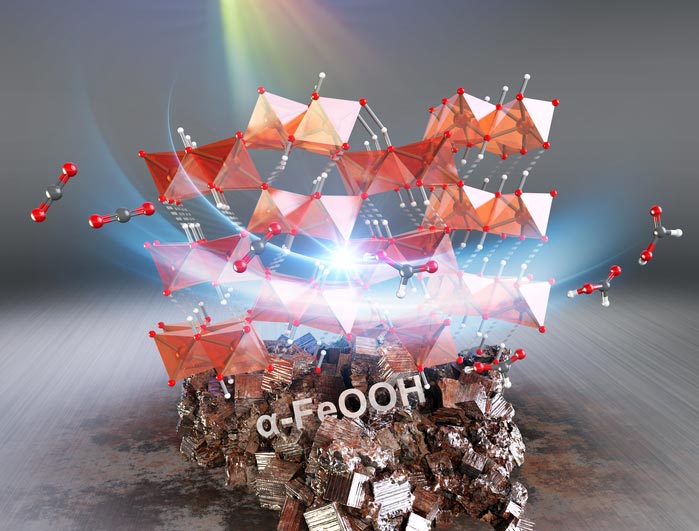Lights, catalyst, reaction!

A wide-spread soil mineral, alpha-iron-(III) oxyhydroxide, was found to become a recyclable catalyst for carbon dioxide photoreduction into formic acid.
Credit: Professor Kazuhiko Maeda
Converting CO2 to formic acid using an alumina-supported, iron-based compound.
Photoreduction of CO2 into transportable fuel like formic acid (HCOOH) is a great way of dealing with CO2’s rising levels in the atmosphere. To aid in this mission, a research team from Tokyo Tech chose an easily available iron-based mineral and loaded it onto an alumina support to develop a catalyst that can efficiently convert CO2 into HCOOH with ~90% selectivity!
The rising CO2 levels in our atmosphere and their contribution to global warming is now common news. As researchers experiment with different ways to battle this problem, one efficient solution has emerged—converting excess atmospheric CO2 into energy-rich chemicals.
Production of fuels like formic acid (HCOOH) by photoreduction of CO2 under sunlight has attracted a lot of attention recently due to the two-fold benefit that can be gained from this process: it can reduce excess CO2 emissions, and also help minimize the energy shortage we are currently facing. Being an excellent carrier of hydrogen with high energy density, HCOOH can provide energy via combustion while releasing only water as a byproduct.
To turn this lucrative solution into reality, scientists developed photocatalytic systems that could reduce CO2 with the aid of sunlight. Such a system consists of a light-absorbing substrate (i.e., a photosensitizer) and a catalyst that can enable the multi-electron transfers required to reduce CO2 into HCOOH. And thus began the search for a suitable and efficient catalyst!
Solid catalysts were deemed the best candidates for this task, due to their efficiency and potential recyclability, and over the years, catalytic abilities of many cobalt, manganese, nickel, and iron-based metal-organic frameworks (MOFs) have been explored, with the latter having some advantages over other metals. However,, most of the iron-based catalysts reported thus far only yield carbon monoxide as the main product, instead of HCOOH.
This problem, nevertheless, was soon solved by a team of researchers from Tokyo Institute of Technology (Tokyo Tech) led by Prof. Kazuhiko Maeda. In a recent study published in Angewandte Chemie, the team presented an alumina (Al2O3)-supported, iron-based catalyst that uses alpha-iron(III) oxyhydroxide (α-FeOOH; geothite). The new α-FeOOH/Al2O3 catalyst showed superior CO2 to HCOOH conversion properties alongside excellent recyclability. When asked about their choice of catalyst, Prof. Maeda says, “We wanted to explore more abundant elements as catalysts in a CO2 photoreduction system. We need a solid catalyst that is active, recyclable, non-toxic, and inexpensive, which is why we chose a widespread soil mineral like goethite for our experiments.”
The team adopted a simple impregnation method to synthesize their catalyst. They then used the iron-loaded Al2O3 material for photocatalytic reduction of CO2 at room temperature in the presence of a ruthenium-based (Ru) photosensitizer, an electron donor, and visible light of wavelength over 400 nanometer.
The results were quite encouraging; their system showed 80-90% selectivity towards the main product, HCOOH, and a quantum yield of 4.3% (which indicates the system’s efficiency).
This study presents a first-of-its-kind, iron-based solid catalyst that can generate HCOOH when accompanied by an effective photosensitizer. It also explores the importance of a proper support material (Al2O3) and its effect on the photochemical reduction reaction.
The insights from this research could aid in the development of new catalysts—free of precious metals—for the photoreduction of CO2 into other useful chemicals. “Our study shows that the road to a greener energy economy doesn’t have to be complicated. Great results can be attained even by adopting simple catalyst preparation methods and well known, earth-abundant compounds can be used as selective catalysts for CO2 reduction, if they are supported by compounds like alumina,” concludes Prof. Maeda.
Journal: Angewandte Chemie
DOI: 10.1002/anie.202204948
Method of Research: Experimental study
Subject of Research: Not applicable
Article Title: Alumina-Supported Alpha-Iron(III) Oxyhydroxide as a Recyclable Solid Catalyst for CO2 Photoreduction under Visible Light
Article Publication Date: 13-May-2022
COI Statement: The authors declare no competing financial interest.
Media Contacts
Emiko Kawaguchi
Tokyo Institute of Technology
kawaguchi.e.aa@m.titech.ac.jp
Office: +81-3-5734-2975
Yuko Shimabayashi
Japan Science and Technology Agency
crest@jst.go.jp
Office: +81-3-3512-3531
Original Source
All latest news from the category: Life Sciences and Chemistry
Articles and reports from the Life Sciences and chemistry area deal with applied and basic research into modern biology, chemistry and human medicine.
Valuable information can be found on a range of life sciences fields including bacteriology, biochemistry, bionics, bioinformatics, biophysics, biotechnology, genetics, geobotany, human biology, marine biology, microbiology, molecular biology, cellular biology, zoology, bioinorganic chemistry, microchemistry and environmental chemistry.
Newest articles

Superradiant atoms could push the boundaries of how precisely time can be measured
Superradiant atoms can help us measure time more precisely than ever. In a new study, researchers from the University of Copenhagen present a new method for measuring the time interval,…

Ion thermoelectric conversion devices for near room temperature
The electrode sheet of the thermoelectric device consists of ionic hydrogel, which is sandwiched between the electrodes to form, and the Prussian blue on the electrode undergoes a redox reaction…

Zap Energy achieves 37-million-degree temperatures in a compact device
New publication reports record electron temperatures for a small-scale, sheared-flow-stabilized Z-pinch fusion device. In the nine decades since humans first produced fusion reactions, only a few fusion technologies have demonstrated…





















